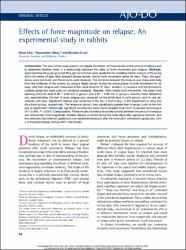| dc.contributor.author | Kılıç, Nihat | |
| dc.contributor.author | Oktay, Hüsamettin | |
| dc.contributor.author | Ersöz, Mustafa | |
| dc.date.accessioned | 10.07.201910:49:13 | |
| dc.date.accessioned | 2019-07-10T19:35:36Z | |
| dc.date.available | 10.07.201910:49:14 | |
| dc.date.available | 2019-07-10T19:35:36Z | |
| dc.date.issued | 2011 | en_US |
| dc.identifier.citation | Kılıç, N., Oktay, H. ve Ersöz, M. (2011). Effects of force magnitude on relapse: An experimental study in rabbits. American Journal of Orthodontics and Dentofacial Orthopedics, 140(1), 44-50. https://dx.doi.org/10.1016/j.ajodo.2009.12.035 | en_US |
| dc.identifier.issn | 0889-5406 | |
| dc.identifier.issn | 1097-6752 | |
| dc.identifier.uri | https://hdl.handle.net/20.500.12511/866 | |
| dc.identifier.uri | https://dx.doi.org/10.1016/j.ajodo.2009.12.035 | |
| dc.description.abstract | Introduction: The aims of this study were to investigate the effects of 2 force levels on the amount of relapse and to determine whether there is a relationship between the rates of tooth movement and relapse. Methods: Approximately 20-g (group I) and 60-g (group II) forces were applied to the maxillary central incisors of 25 young adult (14 weeks of age) New Zealand female rabbits. Active tooth movement lasted 20 days. Then, the appliances were removed, and the incisors were released. The distance between the incisors was measured daily from the midlevels of the crowns by using a digital caliper during the active phase of tooth movement for 20 days, and then relapse was measured at the same level for 37 days. Analysis of variance and the Bonferroni multiple range test were used for statistical analyses. Results: After active tooth movement, the mean total opening amounts were 3.98 ± 0.59 mm in group I and 4.82 ± 0.82 mm in group II, and the mean difference was approximately 0.8 mm. A rapid relapse was observed on the initial days in both groups, and its rate decreased with time. Significant relapse was observed in the first 5 and 8 days of the experiment in 20-g and 60-g force groups, respectively. The relapse in group II was significantly greater than in group I only on the first day of experiment. Statistically significant correlations were found between total tooth movement and relapse (R = 0.896, P <0.001). Conclusions: These results showed a close relationship between the amount of relapse and orthodontic force magnitude. Greater relapse occurred during the initial days after appliance removal, and this indicates that retention appliances are needed immediately after the removal of orthodontic appliances. | en_US |
| dc.language.iso | eng | en_US |
| dc.publisher | Mosby Elsevier | en_US |
| dc.rights | info:eu-repo/semantics/embargoedAccess | en_US |
| dc.subject | Magnitude | en_US |
| dc.subject | Experimental Study | en_US |
| dc.subject | Rabbits | en_US |
| dc.title | Effects of force magnitude on relapse: An experimental study in rabbits | en_US |
| dc.type | article | en_US |
| dc.relation.ispartof | American Journal of Orthodontics and Dentofacial Orthopedics | en_US |
| dc.department | İstanbul Medipol Üniversitesi, Diş Hekimliği Fakültesi, Ortodonti Ana Bilim Dalı | en_US |
| dc.authorid | 0000-0001-7862-2983 | en_US |
| dc.identifier.volume | 140 | en_US |
| dc.identifier.issue | 1 | en_US |
| dc.identifier.startpage | 44 | en_US |
| dc.identifier.endpage | 50 | en_US |
| dc.relation.publicationcategory | Makale - Uluslararası Hakemli Dergi - Kurum Öğretim Elemanı | en_US |
| dc.identifier.doi | 10.1016/j.ajodo.2009.12.035 | en_US |
| dc.identifier.wosquality | Q2 | en_US |
| dc.identifier.scopusquality | Q1 | en_US |


















